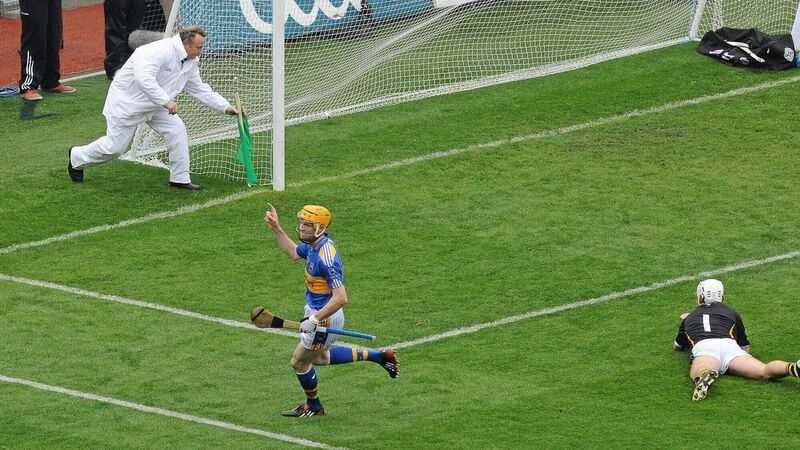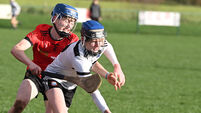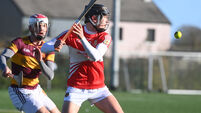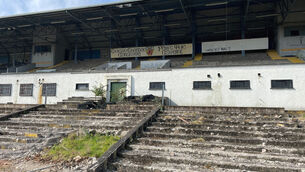Enda McEvoy: Where have all the goals gone? (and should we be worried)

GOALDEN ERA: Tipperary's Lar Corbett nets his side's first goal in the 2010 All-Ireland final against Kilkenny in Croke Park. Picture: Brendan Moran
"Do a column on bringing goals back into hurling,” a (real as opposed to conveniently invented for the purposes of a handy intro) reader pleads.
“Talk about rules that should change. Make goals worth five. Or have a limit on the number of defenders you can have in one half. Or no scoring from inside your own half. Et cetera.”
You see where he’s coming from. Excluding the games involving Westmeath, the fixtures to date in Division 1 of the National League have produced an average of just under two goals per game (27 in 14). By way of comparison the qualifying phase of Division 1 five years ago produced 64 goals in 30 and, scrolling back another five years, the 2011 Division 1 qualifiers produced 67 goals in 28.
It’s not that the rate of goalscoring has fallen off the edge of a cliff. In front of our eyes it has been in decline for a decade. Galway’s 0-26 in the 2017 All Ireland final or Limerick’s 0-30 last December did not come as bolts from the heavens.
Jimmy Barry Murphy’s sleight of eye and wrist, created by the speed and whiplash purity of John Fenton’s delivery, against Galway in 1983? Wouldn’t happen now.
A modern midfielder would immediately be jumped by a gang of opponents; he’d attempt to bullock his way through them; and when a month later the ball arrived in the danger zone JBM would have a bunch of defenders, as opposed to a single Conor Hayes, hanging out of him.
Lar Corbett’s second goal against Kilkenny in as comparatively recently as 2010? Wouldn’t happen now. When Gearoid Ryan flighted the ball towards Noel McGrath for the latter to turn and give the no-look offload to Corbett the reigning champions had only five defenders in their own half of the field, all of them sucked into a central vortex. Unimaginable today.
John Troy making the sliotar not so much talk as recite the poetry of Keats? Wouldn’t happen now because the Offaly lads out the field wouldn’t be able to supply him. They’d pull first time and wouldn’t get the ball back for five minutes.
Taken as a percentage of scores registered, goals have declined because more points are being scored than ever. One end of the seesaw continues to tip skywards.
Of those 28 matches in the 2011 National League, one or other of the teams hit 20 points or more (not including goals) on nine occasions. Not once did both teams hit 20 points or more.
Ho hum, you may say, but hang on. Advance five years to the 2016 league qualifiers. Thirty matches. In 14 of them – nearly half – one side or the other raised 20 white flags or more while in another four both sides reached or surpassed the 20-point barrier.
Advance another five years to the current campaign, admittedly taking place in early summer rather than sodden spring. Fifteen matches, again excluding Westmeath, so far. In five of them both sides have reached or surpassed the 20-point barrier. In nine of the remaining ten encounters one of the teams have done so. Along the way there’s been a 1-27, a 0-26, a 0-30, a 1-28, a 1-26 and two 2-27s.
Hurling has never been as fast, as controlled or as precise as it is today, yet the concomitant tang of soullessness is unmistakable. Let’s run, then, with our correspondent’s first proposal, previously ventilated here on more than two or three occasions. A goal is now worth four points (five points might scare the horses.) What changes?
Does anything change? Is every match transmogrified into a rerun of the 1990 or the 2014 drawn All-Ireland final?
Or does the move backfire because increasing the importance of a goal increases the importance of avoiding the concession of a goal? We wanted a carnival; we got catenaccio. Caveat emptor.
Only the most cynical of columnists would pluck the names of two unfortunates – let’s say Jamie Wall of Mary I and Carlow manager Thomas Mullally – out of the ether and ring up demanding they ponder cold the implications of a four-point goal. So… Wall worries about the law of unintended consequences.
“Managers and coaches, who are risk-averse, will immediately say, ‘No way are we conceding a goal.’ Every team will play a sweeper.”
His counterintuitive suggestion is to make a goal worth four points while making a white flag worth two points, thereby forcing players to get tight on opponents far from goal, thereby freeing up space inside.
“Stand off a Diarmaid Byrnes twice and he puts it over the bar twice. That’s four points conceded.”
One necessity for taking advantage of a four-point goal, Mullally contends, is forwards “who are willing to take the hardship”. Another is lads out the field with the intelligence to create the space and angles for defence-splitting deliveries.
“Any move to increase the rate of goals has to be welcomed. But you have to have players who are capable of taking advantage.”
In rugby, someone recently floated the idea of making a try worth 10 points if the move began inside the scoring team’s own 22’: quite the leap. A less dramatic innovation in hurling might be to award two points for a free inside the 45-metre line, thus bringing forwards more into play and encouraging better defending.
Or how about frees to be taken from the hand up to the 45-metre line in an effort to speed up the game, reduce defenders’ luxury to reset and keep the ball in play for longer?
The present shortage of goals is nothing more than a function of where hurling finds right now in its evolutionary process. But is it something more substantial than a trend that will sooner or later, like all trends, pass? The question is unanswerable.
Micheál Donohoe’s Galway begat John Kiely’s Limerick. Who will the latter beget? Somebody? Anybody? And how soon or how long before some as yet unknown manager sources three 6’6 full-forwards, drops every ball in on top of them, scores a rake of goals as a result and wins an All-Ireland averaging 3-21 per outing as opposed to 0-29 per outing?
The wheel is stuck in the groove. It will not remain stuck forever.

Unlimited access. Half the price.
Try unlimited access from only €1.50 a week
Already a subscriber? Sign in










